|

by Jacques F. Vallee
Journal of Scientific Exploration,
Vol. 4, No. 1, pp. 105- 17
1990
from
ScientificExploration Website
|
Presented at the
Eighth Annual Conference of the Society for Scientific
Exploration, Boulder, Colorado, June 1989. |
Abstract
Scientific opinion has generally
followed public opinion in the belief that unidentified flying
objects either do not exist (the "natural phenomena hypothesis") or,
if they do, must represent evidence of a visitation by some advanced
race of space travelers (the
extraterrestrial hypothesis or
"ETH").
It is the view of the author that
research on UFOs need not be restricted to these two alternatives.
On the contrary, the accumulated data
base exhibits several patterns tending to indicate that UFOs are
real, represent a previously unrecognized phenomenon, and that the
facts do not support the common concept of "space visitors."
Five specific arguments articulated here
contradict the ETH:
-
unexplained close encounters are
far more numerous than required for any physical survey of
the earth
-
the humanoid body structure of
the alleged "aliens" is not likely to have originated on
another planet and is not biologically adapted to space
travel
-
the reported behavior in
thousands of abduction reports contradicts the hypothesis of
genetic or scientific experimentation on humans by an
advanced race
-
the extension of the phenomenon
throughout recorded human history demonstrates that UFOs are
not a contemporary phenomenon
-
the apparent ability of UFOs to
manipulate space and time suggests radically different and
richer alternatives, three of which are pro- in outline form
as a conclusion to this paper.
Initial Hypotheses
Over the last 40 years we have observed the steady development of a
group of aerial phenomena generally referred to as Unidentified
Flying Objects or UFOs.
After a brief attempt to explain the
reports in terms of secret proto-types (the "Advanced Technology
Hypothesis,") two major explanations have captured the attention of
the public, the media and the scientists. These two theories are the
natural phenomena hypothesis and the extraterrestrial hypothesis, or
"ETH."
A large majority of the scientific community, which is typically
unaware of the observational data except as reported in the press,
continues to support the natural phenomena hypothesis. It asserts
that all the reports can be explained as a combination of observing
errors, classical atmospheric phenomena and human-made objects,
possibly combined with little-known psychological illusions which
are of no relevance to physics.
It concludes that no new knowledge is to
be gained from further specialized study of the observations by
professional scientists, perhaps with the exception of marginal
improvements to the documentation of some altered states of
perception.
A majority of the public and the quasi-totality of the UFO
researchers have supported the ETH.
Under this hypothesis UFOs are physical
devices con-trolled by intelligent beings from another planet who
have been visiting the earth as part of a scientific survey begun at
the time of World War very much in the fashion we ourselves plan to
follow in exploring remote planetary environments. In their
interpretation of the phenomenon, this survey includes the
reconnaissance of strategic sites, the gathering of mineral and
plant samples and sophisticated interaction with the human and
animal life-forms present on the planet.
The recent interest in reported abductions of witnesses has
contributed what many UFO researchers regard as convincing evidence
that such extra-terrestrial visitors are conducting a series of
biological interventions de-signed to collect samples of human
tissue and body fluids and are engaged in cross-breeding experiments
for genetic purposes.
Challenges
The slow but steady accumulation of detailed reports and the
continuing research on old cases make it possible to test these
hypotheses against an increasingly documented data base.
The Natural Phenomena Hypothesis does not fare well under
these tests. Many reports are quite specific in terms of the
physical and biological parameters that can be derived from an
analysis of the interaction between the phenomenon and the
environment.
A presentation by Velasco at the 1989
SSE Conference has pointed out that no less than 38% of the cases
studied by the French
CNES (Centre National Spatiales,
the French equivalent of NASA) have failed to be identified in terms
of natural effects (Velasco, 1989).
The environmental interactions most often reported include
abrasions, burns and effects on plants, animals and humans. The
work of Velasco and Bounias in
Trans-en-Provence (submitted for publication) is a case
in point.
So is the recent research done in
Brazil, which will be part of a forthcoming report on field work
conducted privately by the author over the last 10 years (Vallee, in
press; a summary of the Brazilian studies was also presented at the
July 1989 MUFON meeting in Las Vegas, Nevada). The observed
phenomena include radiation effects and have not been accounted for
by a combination of known physical and psychological causes.
At the same time, however, we find that the ETH, too, is
increasingly challenged by the new patterns researchers are
uncovering.
Five major contradictions worthy
of special examination will be studied in this paper.
They have to do,
-
with the surprisingly high
frequency of close encounters
-
with the physiological
description of the "occupants"
-
with the contents of the
abduction reports
-
with the historical extension of
the phenomenon
-
with the physical behavior of
the reported craft
We will discuss these five points in
turn, then we will propose new hypotheses attempting to take these
objections into account.
Argument One -
Close Encounter Frequency
Approximately 20 years ago, when the first catalogue of close
encounter reports was compiled (Vallee 1969), I was surprised to
find that it reached over 900 entries, well beyond the expectations
of most researchers at the time.
With the increased attention now placed
on this category of sightings the lists of unexplained
close encounters have grown beyond
this early catalogue. Estimates place the size of the current sample
between 3,000 and 10,000 cases, depending on the criteria that are
used. We offer the figure of 5,000 as a conservative estimate.
This remarkably large number can and should be used as a challenge
to the natural phenomenon hypothesis:
If UFOs were simply a peculiar
atmospheric effect, such as a plasma discharge, most of the
still-unidentified cases could be accounted for by taking into
consideration the corresponding patterns.
It should also be stressed that we are
not concerned here with the general
appearance of UFOs in the sky but
with close encounters only, those dramatic episodes in which
witnesses describe a phenomenon in their immediate vicinity.
Yet the same argument can also be used against the ETH:
It is difficult to claim that space
explorers would need to land 5,000 times on the surface of a
planet to analyze its soil, take samples of the flora and fauna,
and produce a complete map.
While the ETH could perhaps account for
the 923 landing reports in our 1969 compilation, the theory can no
longer be supported today.
Neither is the figure of 5,000 a good estimate. Many indications
converge to show that only 1 case in 10 may actually get reported.
Therefore, the number of close encounters we need to explain is
probably of the order of 50,000. This does not take into account the
fact that the overwhelming majority of our sources are located in
Europe, the American continent and Australia.
It is logical to assume that the
phenomenon is worldwide, and that we are missing the true magnitude
of the problem at least by a factor of two. This leads to a figure
of 100,000 events.
If we remain faithful to a strict interpretation of the ETH, even
this very large figure still underestimates the real number of
actual landings. Shouldn't we assume that extraterrestrial explorers
would land on our planet without regard for the presence of human
witnesses?
In fact
Claude Poher
and I found (using independent databases) that the
geographic distribution of close encounters does indicate a pattern
of avoidance of population centers, with a higher relative incidence
of landings in deserts and in areas without dwellings (Poher &
Vallee, 1975). If we follow this line of reasoning then it would be
conservative to multiply our number by a factor of 10 to account for
the high ratio of sparsely populated over densely populated lands.
This would place our estimate at million
landings to be explained. In other words, if human witnesses were
equally distributed over the surface of the land and if they
reported every close encounter they observed, the data universe
should contain 1 million records.
This number still does not take into account another important
pattern in the phenomenon, namely its nocturnal character. First
published in 1963 this pattern shows no significant variation
between older and more recent cases and even yields the same
distribution when a very homogenous sample of previously unreported
cases from a single region is analyzed (Poher & Vallee, 1975).
Figure 1 below, shows the frequency of close encounters as a
function of local time of day for 3 different, non-overlapping
samples compiled by the author, namely (A) international catalogue
of 362 cases prior to 1963, (B) an inter-national catalogue
comprising 375 cases for the period 1963-1970 and (C) 100 cases from
Spain and Portugal.
On these curves it can be seen that the number of close encounters
is very low during the daylight hours. It starts increasing about 5
pm and reaches a maximum about 9 pm. It then decreases steadily
until 1 am, then rises again to a secondary peak about 3 am and
returns to its low diurnal level by 6 am.
After these curves were published other researchers have conducted
their own studies which have led to similar results. In particular
Merritt working from UFOCAT files, found that electromagnetic
effect cases, physical trace reports and occupant reports had a
major peak at 9 pm and a low daytime average. The occupant reports
showed a secondary peak about 3 am (Figure 2).
Researcher Randles (1981) conducted her own study of 223
cases from the files of 2 British groups and found a very similar
pattern of high nocturnal activity with a major evening peak and a
secondary predawn peak. Abduction reports, however, showed a maximum
about midnight (Figure 3).
Given such a stable pattern we are led to ask, what would the hourly
distribution look like if we had a constant number of potential
witnesses, in other words if people did not retire at night? The
answer can be approximated by taking the average distribution of
outdoor population as a function of time of day (Szalai, 1972) and
computing a de-convolution against the sighting report curve.
This operation yields an activity curve
that rises continuously throughout the night and peaks about 3 am.
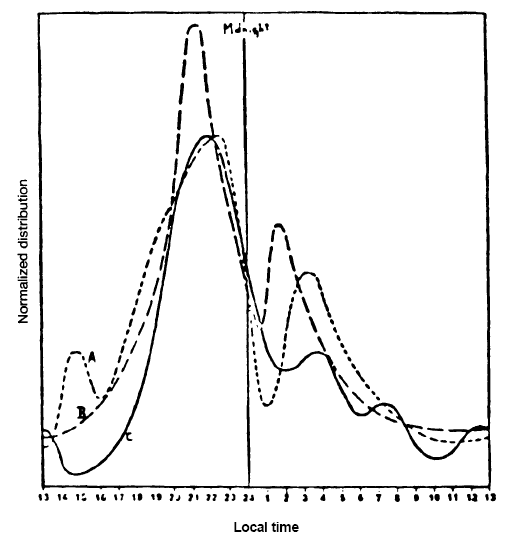
Fig. 1.
Frequency of close
encounter reports as a function of time of day.
A = 362 cases prior
to 1963, all countries
B = 375 cases between
1963 and 1970, all countries
C = 100 cases from
Spain and Portugal only.
It also shows that the total number of
actual events should be 14 times the number of observed phenomena.
This gives a total estimate of 14 million landings in 40 years if we
strictly adhere to the ETH.
The question to be answered is:
What objectives could
extraterrestrial visitors to the earth be pursuing, that would
require them to land 14 million times on our planet?
It should be kept in mind that the
surface of the earth is clearly visible from space, unlike Venus or
other planetary bodies shrouded in a dense atmosphere.
Furthermore, we have been broadcasting
information on all aspects of our various cultures in the form of
radio for most of this century and in the form of television for the
last 30 years, so that most of the parameters about our planet and
our civilization can be readily acquired by unobtrusive, remote
technical means.
The collecting of physical samples would
require landing but it could also be accomplished unobtrusively with
a few carefully targeted missions of the type of our own
Viking experiments on Mars.
All these considerations appear to
contradict the ETH.
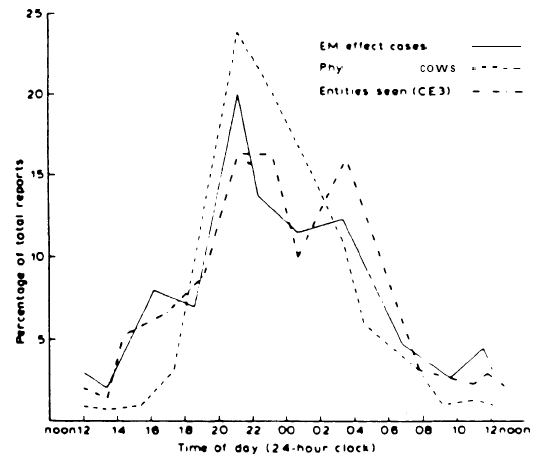
Fig. 2.
Frequency of close
encounter and EM effect cases as a function of time of day
From "Modern Research
by Jenny Randles, 1981, UFO Study: A Handbook for Enthusiasts, p.
194, Figure 18.
Argument Two -
Physiology
The vast majority of reported
"Aliens"
have a humanoid shape that is characterized by two legs, two
arms and a head supporting the same organs of perception we have, in
the same number and general appearance.
Their speech uses the same frequency
range as ours and their eyes are adapted to the same general segment
of the electromagnetic spectrum. This indicates a genetic
formulation that does not appear to differ from the human genome by
more than a few percent.
Such an observation, if the entities were in fact the product of
independent evolution on another planetary body as stated by the
ETH, would stretch our understanding of biology. Humans share the
unique combination of gravity, solar radiation, atmospheric density
and chemical composition known on earth with an array of creatures
closely related to us through evolution, yet deprived of legs and
arms like the dolphins or endowed with multiple eyes like the
spiders.
It should also be kept in mind that the human shape has evolved in
response to an extremely narrow set of constraints.
For example, it would not exist as it
does today if the earth had started out with twice its present mass,
giving a surface gravity of 1.38 times earth normal.
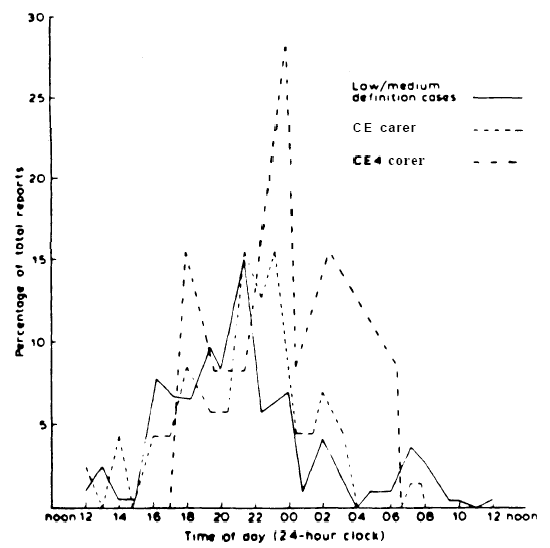
Fig. 3.
Frequency of close
encounter cases, including
abductions, as a function of time
of day
From "Modern Research
by Jenny Randles, 1981,
UFO Study: A Handbook
for Enthusiasts, p. 20 1, Figure 19
Such an environment would have forced
the development of a stronger skeleton and might have precluded
bipeds altogether.
Similarly, a planet with half its
present mass and a surface gravity of 0.73 times what it is now
would have radically affected our shape.
As pointed out by Dole (1969) if
the inclination of the equator had been 60 degrees instead of 23.5
degrees, seasonal weather changes would be intolerable to us:
life would have had great difficulty
in getting started and humans would have evolved in very
different ways.
If the day was 100 hours long instead of
24 hours, mankind as we know it could not have evolved or survived
at all.
How, then, can we expect that extraterrestrial visitors from a
completely different planetary environment would not only resemble
us but breathe our air and walk normally on the earth?
Even if, by some unknown principle of exobiology, the Aliens did
evolve naturally into the humanoid shape, wouldn't they modify their
bodies using genetic engineering techniques to enhance their ability
to work and survive in space, as humans may have to do over the next
century?
This last argument can be countered by assuming that our "Visitors"
have precisely been created through such genetic manipulation into a
form with which we can interact.
But if that is the case, why not produce
human specimens biologically indistinguishable from the earth's
population?
The ETH fails to give a convincing
answer on this point. Even more intriguing is the observation that
the reported display recognizable human emotions such as puzzlement,
interest or amusement (as in
the Betty Hill case of 1961 or the
Valensole case of 1965). This suggests not only biological
similarity but extensive social acculturation.
In summary, the
physiology of the "Aliens"
conforms to human biology and culture to an extent that is
not compatible with the ETH.
Argument Three
- Abduction Reports
The growing number of
abduction reports is being used by
a vocal segment of the UFO research community as further evidence
that we are, in fact, being visited by extraterrestrial aliens, even
if their origin has not yet been revealed.
In the context of the present paper, a
careful survey of the reported behavior of the alleged ufonauts
argues exactly in the opposite direction.
According to current UFO magazines and books, the number of reported
and documented abductions is now measured in multiples of 1,000.
Such incidents are characterized by what the witness reports as
being transported into a hollow, spherical or hemispherical space
and being subjected to a medical examination.
This is often (but not always) followed
by the taking of blood samples, various kinds of sexual interaction,
and loss of time. The entire episode is frequently wiped out of
conscious memory and is only retrievable under hypnosis.
At this writing over 600 abductees have been interrogated by UFO
researchers, sometimes assisted by clinical psychologists. Although
nothing concrete seems to have been learned from these case studies
about the origin and purpose of the visitors, those doing the
investigations are vocal in their claim that the abductions are
further evidence of the ETH.
In order to examine this claim, let us assume that extraterrestrial
intelligence has indeed developed the ability and the desire to
visit the earth. It is a reasonable assumption to expect that such
visitors would know at least as much as we do in the fundamental
scientific disciplines such as physics and biology.
Few ufologists, in fact, argue against
this assumption.
In particular, the visitors would presumably know as much about
medical techniques and procedures as our own practitioners. Today
the average American doctor can draw blood, collect sperm and ova or
remove tissue samples from his or her patients without leaving
permanent scars or inducing trauma.
The current state of molecular biology -
a science which is in its infancy on earth - would already permit
that same doctor to obtain unique genetic "fingerprint" information
from such samples. He could also fertilize the ova and obtain
"test-tube" offspring, and it is conceivable that cloning could
duplicate the beings thus produced ad
A team of scientists equipped with the commonly reported UFO
technology would be in an excellent position to take control of
blood banks, sperm banks or collections of embryos available at
major research hospitals and research centers without creating the
massive disturbances described by abduction researchers. They would
be able to accomplish it while escaping detection.
Equipped with the state-of-the-art
techniques of current U.S. medicine, it would be conceivable that
the entire human race could, in time, be restarted from this pool of
genetic material.
Even gene therapy and the
creation of hybrid species is well within our theoretical
horizon, even if it has not completely been reduced to practice.
None of these accomplishments require the procedural behavior of the
"Alien Doctors" described by abduction researchers. The means of
permanently erasing the memory of the victims through the use of
appropriate drugs are also available in the current pharmacopeia.
Whatever the supposed "Aliens" are
doing, if they actually perform what appear to be shockingly crude
and cruel simulacra of biological experiments on the bodies of their
abductees, is unlikely to represent a scientific mission relevant to
the goals of extraterrestrial visitors.
The answers may have to be sought in
other directions.
Argument Four -
History
The ETH was initially formulated at a time when the earliest
sightings known dated from World War II. It could be validly argued
that this major conflict was detected from space and that the
observation of nuclear explosions on earth precipitated the Aliens'
decision to survey our planet, perhaps in an effort to assess the
human race as a potential threat to other intelligent life-forms.
The mounting proliferation of evidence for similar phenomena not
only before 1945 but during the 19th century and indeed
in the remote past of our culture
has become convincing, although some ufologists, borrowing an
argument from their skeptical opponents, are now pleading that such
data should simply be disregarded.
If it can be established that the phenomenon has indeed existed
through-out history, adapting only its superficial shape but not its
underlying structure to the expectations of the host culture, then
we are unlikely to be dealing with extraterrestrials doing a survey
of the earth. Nor are we dealing with advanced prototypes.
Again, a more sophisticated class of
explanations than both the ETH and the advanced technology
hypothesis must be sought.
In previous works I have pointed out that aerial phenomena very
similar to our
UFOs had been reported in the 9th
century in the form of vessels in the sky, as airships in
the days of Jules Verne, as ghost rockets in 1946 spacecraft in more
recent times, as if they mimicked human expectations. Everything
works as if the UFO phenomenon remained consistently one step ahead
of human technology.
In the last 10 years, as molecular
biology has become more glamorous than electronics or even aerospace
in our modern civilization, it should not be surprising to find the
"Aliens" per-forming simulacra of genetic engineering interventions.
The supporters of the ETH may have
fallen into the trap of a first-level reading of the phenomenon's
message.
Such historical considerations, combined with extensive research on
mythology and folklore have led European researchers like Meheust
(1978, 1985) and Evans (1986) to regard the entire UFO
phenomenon as a projection of the consciousness of the
witnesses. They point out that and legends, too, stay one step ahead
of human scientific realizations.
This "Psycho-Sociological Hypothesis"
has aroused considerable opposition among U.S. ufologists and is now
creating a deep chasm between European and American ufology, with
the former advocating agree, symbolic reading of the discourse
presented by the witnesses.
The abduction claims are especially interesting to the proponents of
the psycho-sociological theory:
It is difficult to find a culture on
earth that does not have an ancient tradition of little people
that fly through the sky and abduct humans (Vallee, 1969, 1988).
It is standard for them to take their
victims into spherical settings that are evenly illuminated and to
subject them to various ordeals such as operations on internal
organs and "astral trips" to unknown landscapes.
Sexual or genetic interaction is also a
common theme in this body of folklore.
Argument Five
- Physical Considerations
As witnesses become less
reluctant in the reporting of their experiences, the notion that
UFOs are "somebody else's spacecraft" (in the words of Friedman)
with the implication of a technology powered by advanced propulsion
systems becomes less tenable, and possibly less appealing
scientifically than other notions.
But the alternative explanations,
notably the psycho-sociological hypothesis, also find themselves
severely challenged.
The phenomena to be explained include not only strange flying
devices that are described as physical craft by the witnesses but
also objects and beings that exhibit the ability to appear and
disappear very suddenly, to change their apparent shapes in
continuous fashion and to merge with other physical objects.
Such reports seem absurd in terms of
ordinary physics because they suggest a mastery of time and space
that our own physical research cannot duplicate today.
However, if these sightings can be
con-firmed either by direct observation, by photographic evidence or
by the weight of statistics they may represent an opportunity to
test new concepts of physical reality at a time when many
theoreticians are grappling with the possible existence of
N-dimensional universes, with N
greater than 4.
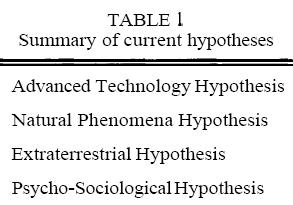
New Hypotheses
In conclusion, it is useful to speculate about several hypotheses
that go beyond the earlier theories listed in Table 1.
These ideas do take into consideration,
with various degrees of success, the five objections we have
re-viewed. These new hypotheses should only be regarded as a means
of stimulating discussion, not as formal proposals (see Table 2).
One such line of speculation has been
advanced by Devereux (1982) who has spoken of UFOs as "Earth
Lights," an unrecognized physical, terrestrial phenomenon which
impresses the consciousness of the witnesses to take the form of a
mental image, possibly a mythological figure.
Derr and Persinger have
extended Devereux' proposals.
In the mid-70's I proposed to approach
the UFO phenomenon as a control system, reserving judgment as to
whether the control would turn out to be human, alien or simply
natural. Such control systems, governing physical or social events,
are all around us.
They can be found in the terrestrial,
ecological and economic balancing mechanisms that rule nature, some
of which are well understood by science.
This theory admits two interesting
variants:
-
An Alien intelligence, possibly
earth-based, could be training us towards a new type of'
behavior. It could represent the "Visitor Phenomenon" of
Strieber (1987) or some
form of "supernature," possibly along the lines of a
"Gaia"
hypothesis
-
Alternately, in a Jungian
interpretation of the same theme, the human collective
unconscious could be projecting ahead of itself the imagery
which is necessary for our own long-term survival beyond the
unprecedented crises of the 20th century.
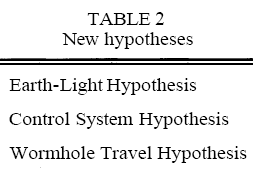
British researcher Randles has
stressed that the analysis of the discourse of abductees
consistently reveals a breakpoint in time, after which the
percipient leaves normal reality behind.
On the "other side" of this boundary
ordinary space-time physics no longer seems to apply and the
percipient moves as if within a lucid dream (or indeed a lucid
nightmare) until re-turned to the normal world. Randles calls this
phenomenon the "Oz Factor."
Building on this observation, one could
theorize that there exists a remarkable state of psychic functioning
that alters the percipient's vision of physical reality and also
generates actual traces and luminous phenomena, visible to other
witnesses in their normal state.
Finally, we could hypothesize extraterrestrial travelers using
radical methods of space-time manipulation, notably the use of
four-dimensional wormholes for space and possibly even time travel.
On this subject, see Morris, Thorne, and
Yurtsever (1988). On multidimensional models, see Mallove (1988, p.
255).
Such travelers could perform many of the
physical feats ascribed to
ufonauts and they could also
manifest simultaneously throughout what appears to us as different
periods in our history. This hypothesis represents an updating of
the ETH where the "extraterrestrials" can be from anywhere
and anytime, and could even originate from our own
earth.
The arguments for a multidimensional
approach to the natural history of the UFO phenomenon have been
developed by the author in the book
Dimensions
(Vallee, 1988).
Conclusion
Exciting as an extraterrestrial visitation to earth would be, this
paper has pointed out that in the current state of our knowledge UFO
phenomena are not consistent with the common interpretation of this
hypothesis.
Neither do the observed patterns support
the theory that all UFOs can be explained as combinations of natural
effects, or as psycho-sociological processes. Therefore it is
proposed that future research in this field could fruitfully explore
alternative hypotheses, such as those involving either
natural or artificial control systems, earth lights or wormhole
travel.
The arguments raised here are not intended as a complete refutation
of the ETH or the natural phenomena hypothesis. Until the nature and
origin of UFO phenomena can be firmly established it will naturally
be possible to hypothesize that extraterrestrial factors, including
undiscovered forms of consciousness, are playing a role in its
manifestations.
But any future theory should
constructively address the facts we have reviewed.
At a minimum, the idea of
extraterrestrial intervention should be updated to include current
theoretical speculation about other models of the physical universe.
References
Bounias, M. Biochemical traumatology
as a potent tool for identifying actual stresses elicited by
unidentified sources: Evidence for plant metabolic disorders in
correlation with a UFO landing. Submitted for publication to the
Journal of Exploration. Original report included in: CNES.
(1983, March). Note Technique 16, Toulouse, France.
Devereux, P. (1982). Earth lights. Wellingborough: Turnstone
Press.
Dole, S. planets for man. New York: Blaisdell.
Evans, H. (1 986). Visions, apparitions, alien visitors. London:
Aquarian.
Mallove, E. F. (1988, September). The self-reproducing universe.
Sky and Telescope, p. 255.
Meheust, B. (1978). Science-fiction et soucoupes volantes.
Paris: Mercure de France. Meheust, B. (1985). Soucoupes volantes
et folklore. Paris: Mercure de France. F. (1977, Winter).
Statistical notes on the UFO phenomenon. CUFOS Bulletin.
Moms, M. S., Thorne, K. S., Yurtsever, U. (1988, September 26).
Wormholes, time ma-chines and the weak energy condition.
Physical Review Letters,
Poher, C., Vallee, J. F. (1975, January 20). Basic patterns in
UFO observations. American Institute of Aeronautics and
Astronautics, 13th Aerospace Sciences Meeting, Pasadena,
California (AIAA Paper
Randles, J. (198 1). UFO study. London: Robert Hale.
Strieber, W. (1987). Communion. New York: Morrow.
Szalai, A. (Ed.). (1972). The use of time: Daily activities of
urban and suburban populations in twelve countries. The Hague:
Mouton.
Vallee, J. F. (1969). Passport to Magonia. Chicago: Regnery.
Vallee, J. F. (1988). Dimensions. Chicago: Contemporary Books.
Vallee, J. F. (in press). Confrontations. New York: Ballantine.
Velasco, (1989, June). Methods, processing and analysis of data
concerning unidentified aerospace phenomena. SSE Conference,
Boulder, Colorado.
Velasco, Report on the analysis of anomalous physical traces:
The 1981 UFO case. Submitted for publication to the Journal of
Exploration. Complete report about Trans available from: CNES.
(1983, March). Enquete 81/01, Analyse d'une trace. Note
Technique Numero 16, Toulouse, France.
|





